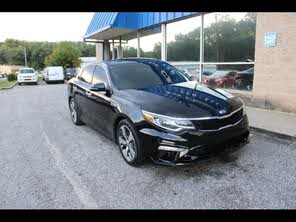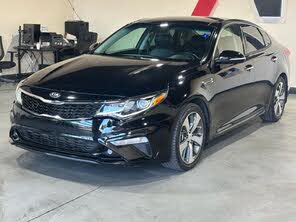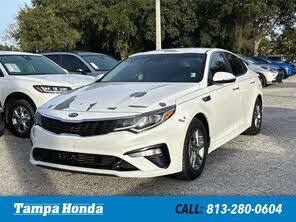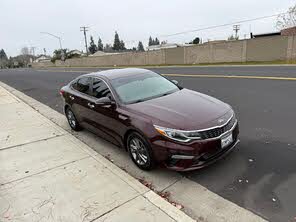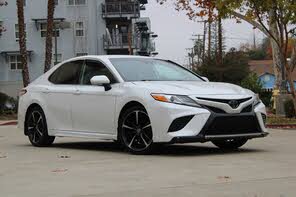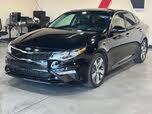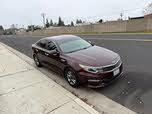2019 Kia Optima vs 2020 Toyota Camry
Overview | |
MSRP$22,900 | MSRP$24,425 |
Listings683 | Listings1401 |
Ratings & Reviews | |
User Reviews | User Reviews |
Expert reviews9.0 out of 10 | Expert reviews7.5 out of 10 |
Pros
Cons
| |
2019 Kia Optima Reviews SummaryEven though Americans appear to be trading in cars for good, the midsize family sedan looks better than it’s ever been. Nearly every choice in the segment sports impressive design, engineering, and equipment, and the 2019 Kia Optima shows just how good a typical midsize car can be. From its stylish looks and wide range of engine choices to its roomy interior and sophisticated safety technologies, the 2019 Optima is more than just a great value. It’s a great car. | |
2020 Toyota Camry Reviews SummaryIf you can't beat them, join them. That seems to be Toyota's philosophy in updating the eighth generation of the Camry for the 2020 model year. This latest version of the perennial best seller debuted in 2017 as a 2018 model—and promptly lost its sales crown to Toyota's own RAV4 crossover SUV. As buyers continue to defect from cars, Toyota hopes to entice more shoppers to stick with its midsize sedan by offering all-wheel drive on the Camry for the first time since 1991. Also new for 2020 is the Camry TRD, a sportier version with a 301-horsepower V6 engine that makes its case to a buyer who might never have considered a Camry. | |
No video found | |
Popular Features & Specs | |
Engine2.4L 185 hp I4 | Engine2.5L 203 hp I4 |
Drive TrainFWD | Drive TrainFWD |
Seating Capacity5 | Seating Capacity5 |
Horsepower185 hp @ 6000 rpm | Horsepower |
MPG City24 | MPG City29 |
MPG Highway33 | MPG Highway41 |
Engine | |
Engine Name2.4L 185 hp I4 | Engine Name2.5L 203 hp I4 |
Torque178 lb-ft @ 4000 rpm | Torque |
Horsepower185 hp @ 6000 rpm | Horsepower |
DrivetrainFWD | DrivetrainFWD |
Fuel Economy | |
MPG City24 | MPG City29 |
MPG Highway33 | MPG Highway41 |
Interior | |
Seating Capacity5 | Seating Capacity5 |
Safety | |
Front Crash Overall5 | Front Crash Overall5 |
Side Crash Overall5 | Side Crash Overall5 |
Dimensions & Capacity | |
Cargo Space15.9 cu ft | Cargo Space14.1 cu ft |
Curb Weight3230 lbs | Curb Weight3241 lbs |
Height57.7 in | Height56.9 in |
Length191.1 in | Length192.1 in |
Width73.2 in | Width72.4 in |
Wheelbase110.4 in | Wheelbase111.2 in |
Maximum Payload | Maximum Payload925 lbs |
Number of doors4 | Number of doors4 |
Overview | ||
MSRP | $22,900 | $24,425 |
Listings | ||
Ratings & Reviews | ||
User reviews | ||
Expert reviews | 9.0 out of 10Read full review | 7.5 out of 10Read full review |
Pros & cons | Pros
Cons
| |
Summary | Even though Americans appear to be trading in cars for good, the midsize family sedan looks better than it’s ever been. Nearly every choice in the segment sports impressive design, engineering, and equipment, and the 2019 Kia Optima shows just how good a typical midsize car can be. From its stylish looks and wide range of engine choices to its roomy interior and sophisticated safety technologies, the 2019 Optima is more than just a great value. It’s a great car. | If you can't beat them, join them. That seems to be Toyota's philosophy in updating the eighth generation of the Camry for the 2020 model year. This latest version of the perennial best seller debuted in 2017 as a 2018 model—and promptly lost its sales crown to Toyota's own RAV4 crossover SUV. As buyers continue to defect from cars, Toyota hopes to entice more shoppers to stick with its midsize sedan by offering all-wheel drive on the Camry for the first time since 1991. Also new for 2020 is the Camry TRD, a sportier version with a 301-horsepower V6 engine that makes its case to a buyer who might never have considered a Camry. |
Video | No video found | |
Popular Features & Specs | ||
Engine | 2.4L 185 hp I4 | 2.5L 203 hp I4 |
Drive Train | FWD | FWD |
Seating Capacity | 5 | 5 |
Horsepower | 185 hp @ 6000 rpm | |
MPG City | 24 | 29 |
MPG Highway | 33 | 41 |
Engine | ||
Engine Name | 2.4L 185 hp I4 | 2.5L 203 hp I4 |
Torque | 178 lb-ft @ 4000 rpm | |
Horsepower | 185 hp @ 6000 rpm | |
Drivetrain | FWD | FWD |
Fuel Economy | ||
MPG City | 24 | 29 |
MPG Highway | 33 | 41 |
Interior | ||
Seating Capacity | 5 | 5 |
Safety | ||
Front Crash Overall | 5 | 5 |
Side Crash Overall | 5 | 5 |
Dimensions & Capacity | ||
Cargo Space | 15.9 cu ft | 14.1 cu ft |
Curb Weight | 3230 lbs | 3241 lbs |
Height | 57.7 in | 56.9 in |
Length | 191.1 in | 192.1 in |
Width | 73.2 in | 72.4 in |
Wheelbase | 110.4 in | 111.2 in |
Maximum Payload | 925 lbs | |
Number of doors | 4 | 4 |
The 2019 Kia Optima, while not as revolutionary in design as its 2011-2015 predecessor, still captured attention with its trademark tiger-nose grille, sassy fender-vent trim, and available black panoramic glass roof. This version of Kia’s midsize car offered a variety of trim levels, allowing consumers to find their ideal match in terms of both aesthetics and budget. However, the availability of interior colors was limited, except for black, making it a bit challenging to find the perfect color combination.
Prices ranged from $22,900 for the base Optima LX to $35,790 for the SX Turbo with the luxurious Limited Package. The plug-in hybrid model was the most expensive, topping $42,000 with all options. Federal tax credits and state incentives could help mitigate the cost. The test car featured SX Turbo trim, but not the Limited Package, and at $33,505, it boasted a blacked-out exterior, machined-face 18-inch aluminum wheels, red brake calipers, and dazzling white pearl paint. Inside, black leather with red inserts, a flat-bottom steering wheel, and upgraded instrumentation added a sporty touch.
In comparison, the 2020 Toyota Camry marked a bold shift from its historically reliable but sometimes bland design. This generation of the Camry was expressive in a way previous models never were, featuring a bold front fascia and taut lines. Some design cues seemed inspired by BMW, adding a sporty flair previously unseen in Camrys. With 14 exterior color options, including an available black roof, this version aimed to be fashionable.
Inside, the Camry used uniformly nice materials and a driver-focused dashboard to make even the basic trims feel upscale. The TRD model stood out with red trim accents and bright red seatbelts, reminiscent of premium sports cars. Although it fell short of being a luxury sedan, the 2020 Camry made strides in presenting itself with luxury-like qualities, especially with the sumptuous leather and wood in the higher trim levels.


















The 2019 Kia Optima offered a selection of five powertrains, including hybrid options. The base LX and sporty S trims came with a naturally aspirated 185-hp 2.4-liter four-cylinder engine. The mid-grade EX Turbo featured a 178-hp 1.6-liter turbocharged engine known for its fuel efficiency. The hybrid models provided 41 mpg in combined driving, with the plug-in hybrid capable of 28 miles of electric range before reverting to a gas-electric hybrid.
The SX Turbo test car packed a 2.0-liter turbocharged four-cylinder engine, producing 245 hp and 260 lb-ft of torque. This engine delivered smooth, linear acceleration rather than the immediate thrust typical of other turbocharged units. A 6-speed automatic transmission and four driving modes—Eco, Comfort, Sport, and Smart—allowed for a customizable driving experience. The SX Turbo's unique rack-mounted electrically-assisted steering, sport-tuned suspension, and larger brakes contributed to a firm yet not harsh ride quality. However, excessive body motion on rough roads and some steering imprecision slightly diminished the driving confidence.
The 2020 Toyota Camry, by contrast, offered four distinct powertrains. The range-topping 3.5-liter V6 produced 301 hp, providing smooth power delivery but lacking in excitement for the TRD model. The 2.5-liter four-cylinder engine made 203 hp (or 206 hp in XSE trim) and, paired with an eight-speed automatic transmission, offered a lighter and more responsive driving experience. The TRD model further featured a specially tuned and lowered suspension, upgraded brakes, and high-performance tires, enhancing sportiness at the expense of traditional Camry comfort.
The introduction of AWD added functionality without significant compromises to passenger or cargo space. The front-drive Camry achieved an EPA combined fuel economy rating of 31 mpg, while the AWD version dropped to 28 mpg. The front-drive V6 models delivered just 26 mpg, with the TRD rated at 25 mpg.
As a daily driver, the 2019 Kia Optima provided comfort, simplicity, and ample storage. Controls were logically laid out and easily accessible, with tactile buttons and knobs reducing the need for interaction with the touchscreen infotainment system. The Optima boasted a spacious 15.9-cubic-foot trunk, numerous storage compartments, adjustable front seats with available heating and ventilation, and rear air-conditioning vents with quick-charging USB ports. The backseat offered excellent legroom and comfort, making it a practical choice for families.
The Smart Trunk feature was both a boon and a bane. While it automatically opened the trunk when you stood behind the car with the key fob, it sometimes triggered unintentionally.
Meanwhile, the 2020 Toyota Camry was user-friendly and ergonomically sound. Most controls were intuitively placed, but an incongruous row of buttons on the lower left dashboard was a minor inconvenience. The center console cleverly accommodated the shifter, cupholders, phone tray, and storage bin, maintaining a roomy front cabin. Despite this, rear-seat legroom had slightly decreased compared to previous generations, and the overall passenger volume was marginally less. With a smaller 15.1-cubic-foot trunk—the same size as a Honda Civic's—it fell short of competitors like the Accord.
Notably, the addition of AWD did not compromise trunk or rear-seat space due to structural modifications, maintaining the front-drive version's cargo and passenger capacities.
Kia equipped the 2019 Optima generously with tech features, including an 8-inch touchscreen with the latest UVO technology, Bluetooth, Apple CarPlay, Android Auto, Siri Eyes Free, voice recognition, a USB port, and a reversing camera. Higher trims like the S and EX Turbo added satellite radio and UVO eServices with emergency response. The SX Turbo included a navigation system, HD Radio, and a Harman Kardon premium audio system.
However, UVO eServices relied on the smartphone's data plan and signal, limiting its utility. The new smartphone app for remote access and starting the car was a welcome addition.
Toyota's 2020 Camry finally integrated Android Auto along with Apple CarPlay, Amazon Alexa compatibility, and SiriusXM satellite radio. The standard infotainment system, though functional and responsive, lagged behind competitors in terms of graphics and navigation software. The 7-inch standard screen felt small, with an optional 8-inch upgrade available. The system included USB-A ports and an optional Qi wireless charging pad, but no USB-C ports.
WiFi Connect and Remote Connect offered additional connectivity and remote functionality, making the Camry more tech-savvy. Higher trims featured larger instrument panel displays and an optional 10-inch head-up display, enhancing the driver's experience.
CarGurus highlights

According to CarGurus experts, the overall rating for the 2019 Kia Optima is 9.0 out of 10, while the 2020 Toyota Camry scores 7.5 out of 10. With a higher overall rating, comprehensive safety features, and a more spacious interior, the 2019 Kia Optima stands out as the better choice for most consumers. While the Toyota Camry offers a sportier driving experience and advanced tech, the Optima’s value for money and comfort make it the recommended option.
Choose the 2019 Kia Optima if:
- You prioritize spacious interiors and excellent rear-seat comfort.
- You value comprehensive standard safety features and top-notch crash test ratings.
- You prefer a more budget-friendly option with a wide variety of trim levels and features.
Choose the 2020 Toyota Camry if:
- You seek a blend of sportiness and comfort in a midsize sedan.
- You want the latest in smartphone connectivity, including Apple CarPlay and Android Auto.
- You require all-wheel drive functionality without compromising passenger or cargo space.
CarGurus highlights

According to CarGurus experts, the overall rating for the 2019 Kia Optima is 9.0 out of 10, while the 2020 Toyota Camry scores 7.5 out of 10. With a higher overall rating, comprehensive safety features, and a more spacious interior, the 2019 Kia Optima stands out as the better choice for most consumers. While the Toyota Camry offers a sportier driving experience and advanced tech, the Optima’s value for money and comfort make it the recommended option.
Choose the 2019 Kia Optima if:
Shop Now- You prioritize spacious interiors and excellent rear-seat comfort.
- You value comprehensive standard safety features and top-notch crash test ratings.
- You prefer a more budget-friendly option with a wide variety of trim levels and features.
Choose the 2020 Toyota Camry if:
Shop Now- You seek a blend of sportiness and comfort in a midsize sedan.
- You want the latest in smartphone connectivity, including Apple CarPlay and Android Auto.
- You require all-wheel drive functionality without compromising passenger or cargo space.

By: CarGurus + AI
At CarGurus, our team of experienced automotive writers remain at the heart of our content operation, conducting hands-on car tests and writing insightful guides that are backed by years of industry experience. To complement this, we are harnessing AI to make our content offering more diverse and more helpful to shoppers than ever. To achieve this, our AI systems are based exclusively on CarGurus content, ratings and data, so that what we produce is both unique to CarGurus, and uniquely helpful to car shoppers.

